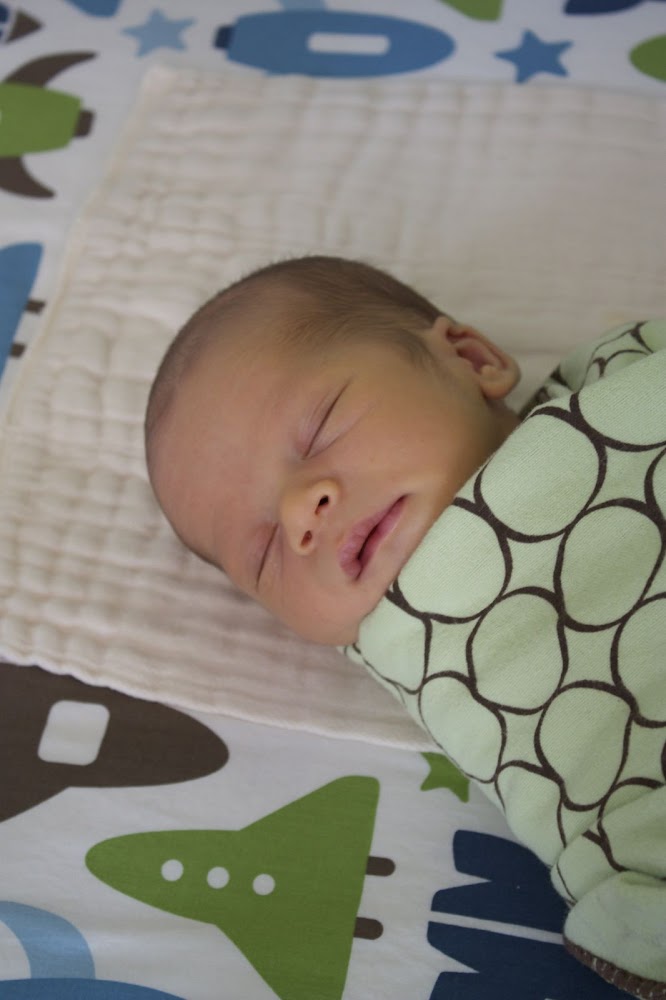
My apologies for the delay in getting the news out through this avenue but many of you have already heard - Benton Gray Vargo was born on July 20, 2011. He was a healthy 8lbs 9oz.
For months, and especially for the last few weeks of the pregnancy I had been waiting anxiously and wondering always "what is next?" "how does this go down?" I began to find out just after 5pm on a Tuesday when Lauren's water broke. We ran out to stock up on pet food and ate our own dinner before heading to the hospital around 10:30 that night. If the water breaks before full fledged labor, most hospitals will put you on a pseudo-clock since the risk of infection goes up once the membranes have ruptured. We hesitated to go to the hospital to see if she could labor at home and hopefully progress a bit before going there and hearing that we needed pitocin to move things along. At the hospital they let us walk laps around the ward to try and get things going but contractions stayed about 6-8 minutes apart. By the morning (15 hours from water breakage) they wanted us to take steps to move it along. This means starting a steady dose of pitocin to move the contractions closer together with greater regularity. We worked at this for about 5 hours, trying all kinds of different breathing and poses and shifting weight and listening to some relaxation sounds Lauren has on her iPhone.
When the doctor came in around 1pm Wednesday, we found out that there was no noticeable progress in her dilation. This news completely deflated us. Lauren had been working so hard through painful contractions and the news that the last 5 hours had yielded no reward was crushing. We were now about 20 hours past the water breaking and no closer to the end goal. The decision to get the epidural was not an easy one. There are all manner of sources of information for how you should go through your delivery out there and many pivot around the subject of the medical intervention and, in particular, the epidural. It's gets a lot of attention and it was so difficult because it came with a fair bit of uncertainty. Would this slow down Lauren's progress even further? Would she even know what was going on during the whole thing? Would she be miserable? After hooking up the epidural, the every-3-minute contractions came and went with little fanfare. This continued for about 4 hours. Lauren got to relax a bit if that's possible, and for the first time since arriving at the hospital I found myself once again full of worry and curious anticipation about how the whole thing was going to go down from here on out.
The doctor finally came in around 6pm and upon inspection found everything in its right place, so to speak. We were about 25 hours past the water breaking and we were in a position to start pushing. This was the best news we could have hoped for. We were done with the active labor, we were going to proceed without needed further intervention or surgery and we were finally going to have a child after all this waiting. The doctor promptly left to finish his rounds and the nurse prepped Lauren for pushing. I think she could sense our excitement at this latest development and tried to temper it by mentioning that, on average, the pushing phase for first time births last 2 hours. She walked Lauren through how to push and breathe together - 3 pushes per contraction and after two contractions she was calling for more nurses to set up the tables and get he doctor back in there. The whole pushing phase lasted about 20 minutes and Benton was born. I was able to be present for the whole thing and everyone did a great job. Lauren even got to complete the birth by reaching down and pulling Benton out and onto her chest. This part of the birth, blew my mind and is still my favorite part. It exceeded all of the expectations I had for our experience. One nurse said to us that we did this whole delivery thing backward with the water breaking and the labor, but if anything is clear after the process it is that there is no standard for what happens next, or how it goes down.
The rest of our time in the hospital was great. You're running on a great high and you seem to roll with whatever gets thrown at you. I was impressed by the size and complexity of hospital operations. If you don't spend much time in them you forget how amazing they are. The nurses are also great. You get to know them and you feel like you're in good hands. When you leave you feel like they are going to miss you but it is probably more of a one way street. They do it all again the next day or with the next patient.
Now we've been home for just over a week. He sleeps and eats well but we have not gotten as much sleep as we should because we just stare at him most of the time. Thanks to everyone for their support and thoughts as we've progressed through this. We are all loving it right now. No one is really thinking about what is next or worrying about how the next step happens, we're just enjoying this now.










